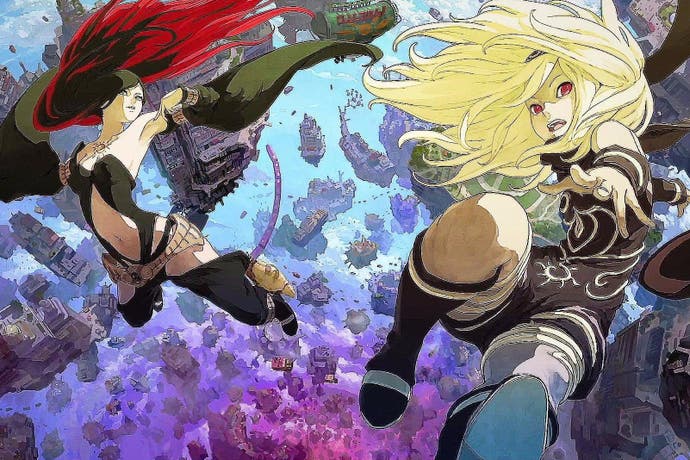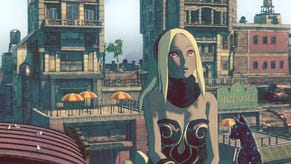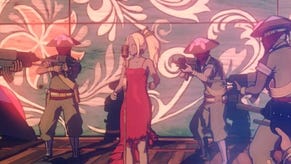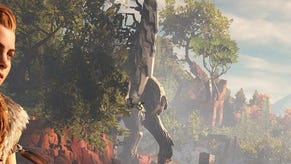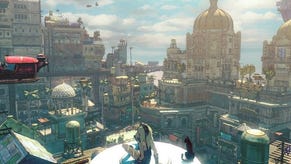Tech Analysis: Gravity Rush 2
Unique, imaginative - and powered by excellent technology.
We're just three weeks into 2017 and already we have a brand-new PS4 platform exclusive in the form of Gravity Rush 2 - Sony Japan's physics defying action game. With the original release created with PlayStation Vita in mind, we were excited to see what the development team could achieve on much more powerful hardware. The opportunity to push environment complexity and interactions through the roof offers a huge amount of potential, so we were eager to check that out - and to put the PS4 Pro features through their paces.
Let's start with the basics - Gravity Rush 2 has been in development for five years now and was designed specifically for the standard base PlayStation 4. With that in mind, it should come as no surprise that the game operates at a native 1920x1080 paired with an efficient form of post-process anti-aliasing that helps avoid temporal shimmering and jagged edges. Image quality is a strong point here, which is impressive considering the bright colors and huge draw distance on display.
The PlayStation 4 Pro, on the other hand, dropped just prior to the game's original release date of early December so it stands to reason that the development team would not have built in support for the new system from the ground up. The results are intriguing though, with pixel counting suggesting a native 2160p - but there is more to this tale.
Like Bound before it, Gravity Rush 2 appears to make use of the geometry upscale rendering technique which Mark Cerny discussed with us last year. This effectively enables the game to display a 'pseudo-4K' image in which all geometric edges appear to operate at a native 4K while pixel shader operations continue to operate at the standard 1080p. So, while the edges of buildings are razor sharp on the PS4 Pro, the textures and shading contained within are displayed at quarter resolution. It's ultimately an effective trade-off when played on a 4K TV at a normal viewing distance, but clearly the more demanding checkerboard rendering produces visually superior results.
This extends to non-4K displays as well - Gravity Rush 2 offers full support for downsampling when using PS4 Pro with a 1080p display. After the release of The Last Guardian and changes made to The Last of Us Remastered, it's encouraging to see a game like Gravity Rush 2 offer this experience. It should also be noted that the demo version released late last year is based on older code and lacks support for the PS4 Pro while also suffering from somewhat sluggish performance. If you sampled the demo and were concerned about the final game, don't be. It looks and plays much better in its final iteration both on the Pro console as well as a base PS4.
What sets Gravity Rush 2 apart from so many other games on the market today is the way in which players can navigate the world. At any point, you can fly off in any direction taking people and objects along for the ride. This level of freedom demands large environments and robust physics interactions to work at its best and it's here where Gravity Rush 2 impresses most with massive floating cities to zip through and plenty of destructibles around every corner.
The physics stand out as the game's crowning achievement. The streets are littered with objects such as tables, crates and chairs which can be pulled into your gravitational field and tossed around the scene with reckless abandon. Early on, a powerful attack from a massive boss shatters a group of huge stone pillars sending debris flying everywhere. It's impressive to behold and represents a significant improvement over the original game. Crucially, all of these splinters and pieces of debris can be used to attack enemies - it's not just for show.
The effect is enhanced by the inclusion of robust post-processing that includes high quality per-object motion blur. Every motion is accentuated by the effect lending weight to the action in a big way. The motion blur also helps the game appear smoother despite the frame-rate cap of 30fps. When these two techniques come together, the results are impressive - possibly the best 30fps implementation we can expect.
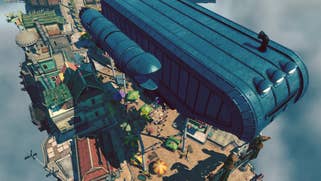

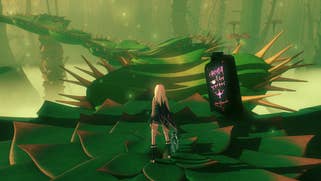
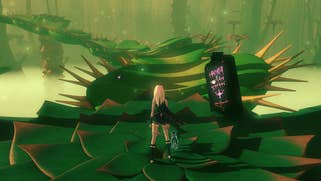
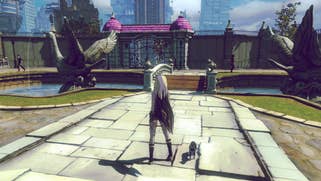

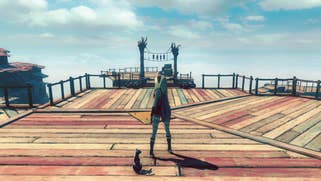

The environments deserve praise too; the game centers on the journey of Kat and the people onboard the settlement of Banga - a flying collection of airships which form a small society that spends its days mining gems. The mobility of this settlement enables the developers to change the scenery in a natural way to fit the progression of the story, leading to some dramatic moments. Following the first chapter, for instance, players are introduced to a sprawling metropolis that spreads out in all directions.
It isn't long before you receive a mission that asks you to jump off the city into the clouds below. It's this discovery that there are massive areas miles above and below the main hub that really impresses. The game world is massive and the engine handles it well. If you watch the scenery while flying it becomes clear that a moderately aggressive level of detail system is used here. Objects and crowds are drawn in as you approach but the main structures remain fully detailed even at a great distance.
Once down on the streets, we were quick to notice the inclusion of parallax occlusion maps - a rarity in a Japanese developed game. This effect helps create depth within flat surfaces and it is applied liberally across the world. The one downside here is that texture filtering isn't especially high, likely due to the cost of combining a high level of anisotropic filtering with the POM technique. We also noticed a subtle difference in shadow quality on PS4 Pro versus the standard system - shadow maps appear slightly more pixelated at points on the Pro, most likely to maintain faster performance with the higher resolution.
Then we come to performance. Like the original Vita iteration of Gravity Rush, the sequel targets 30 frames per second rather than 60fps like the PS4 remaster. This may be initially disappointing but the scale and complexity of the game's interactions likely render 30fps impossible. Gravity Rush 2 is a busy game with a huge number of disparate objects flying around the scene at any one time.
Thankfully, the game manages to reach and maintain a stable level of performance. Whether you're playing on a base PS4 or a Pro, you can expect that the overwhelming majority of your time with the game will be spent at a locked 30 frames per second. Coupled with the excellent motion blur, the game manages to look remarkably smooth in motion - the same reason why games like Sunset Overdrive and Uncharted 4 appear so fluid in motion despite running at 30fps. It is possible to run into drops during the very busiest of scenes but these issues are rare. We had to spend hours playing the game before running across any situations in which slowdown popped up and, even then, it happens so infrequently that it is not really an issue.
A number of PS4 Pro owners have continued to lament the fact that Pro versions of games are not offering a 60 frames per second mode, but it seems unlikely that it would have been possible here. The bottleneck would become the CPU and the end result would likely be an unstable frame-rate. In cases where the original PS4 quality visuals remain intact while the cap is removed, we have yet to see a Pro version of a game reach a stable 60fps. Rise of the Tomb Raider spends a lot of time below 60fps as doe less complex titles like Knack and Steep. It is likely that aspects of the game itself, such as the physics simulation, would have to change to support 60fps even on the Pro.
And those physics, along with the rest of the visuals, contribute greatly to the overall look of the game. It's an appealing title and the engine does a great job at handling these elements smoothly. In some ways, the design of the world and the use of crowds almost reminds us of Jet Set Radio Future. It really is a beautiful game all around but what of the rest of the presentation outside of the gameplay?
As with the original game, Gravity Rush 2 divides its story sequences between comic book panels and pre-rendered cinematics. When played on a PS4 Pro using the 4K mode, this impacts how these elements are displayed then. The videos are upscaled to 4K using a nearest neighbour algorithm which is a fast technique which preserves pixel edges resulting in sharp image quality. Essentially, one 1080p pixel is four pixels when upscaled to 4K with no additional filtering. In this case, it works well, but the videos themselves are limited by noticeable macroblocking in some scenes.
The comic book panels seem to vary in quality throughout with some art appearing upscaled from 1080p while other shots appear very sharp and clean. Thankfully, the rest of the user interface and the fonts used throughout the game receive the full 4K treatment and appear extra sharp on a 4K display. While it's easy to take the UI for granted, it is interesting to see how different developers adapt to the new console.
Ultimately, Gravity Rush 2 is a beautiful game which offers something that has become increasingly rare as of late - a solid day one experience. Even before release, Gravity Rush 2 is a polished, complete game that looks remarkable and runs very well on all PlayStation hardware. It's quite the showpiece with impressive physics work on display alongside towering environments.
It also gives us a look at what we can expect from the geometry rendering technique mentioned earlier. While it was previously featured in Bound, that game makes use of very few textures so it's only now that we can see how it works in a more richly detailed game. Overall, it's a good fit for the kind of artwork utilised in Gravity Rush 2 and manages to look reasonably sharp in action at normal viewing distances. However, its effectiveness depends very much on the style of artwork chosen by the developer. Previously, we've seen a tech demo for InFamous First Light where we could cycle between 1080p, geometry 4K, native 4K and checkerboard 1800p. Geometry rendering looked 'odd' where and the final checkerboard solution was clearly the right way to go in improving visuals while maintaining performance.
In the end, it's great to see a new game out of Sony's Japanese studio with such impressive visuals and technical performance. It's a unique, beautiful game that feels quite unlike anything else out there. If you're looking for something a little different, be sure to give it a try.
